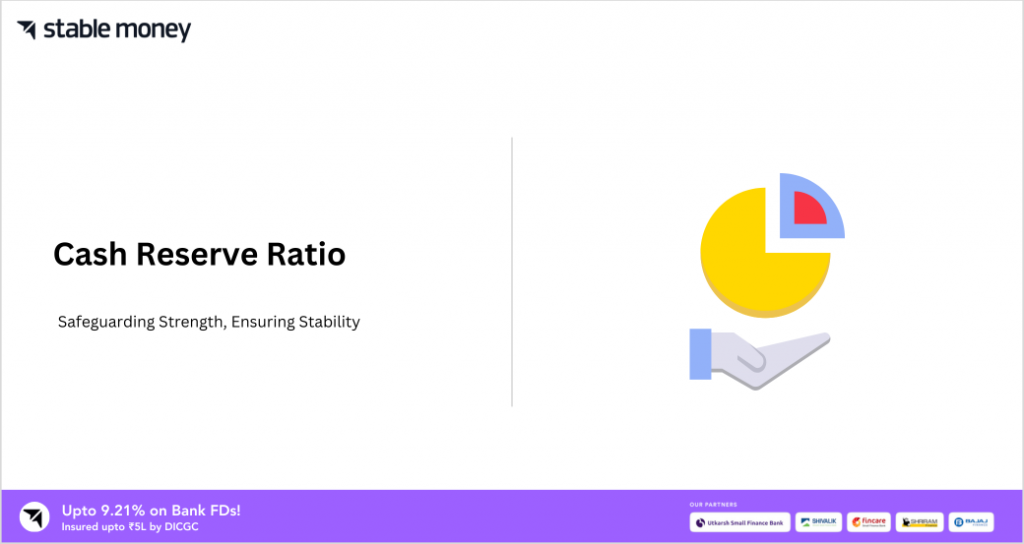
The cash Reserve Ratio or CRR is an essential tool that regulates the money supply in the Indian economy. It determines the amount of cash that commercial banks must keep with the Reserve Bank of India. This blog discusses the concept of CRR, its purpose, determination and impact on banks and the economy.
What is Cash Reserve Ratio With an Example?
Cash Reserve Ratio is a ratio that banks must maintain. Reserve Bank decides this ratio. It is the percentage of total deposits that banks must keep with RBI. This ratio is used to monitor and control money supply. If the ratio is high, less money is available to banks for loans. Currently, it is 4.5%. For if deposits with a bank are Rs.100 cr, as CRR is 4%, it must keep Rs.4.5 cr with RBI; rest, rest Rs.95.,5 cr can be used for loans, etc. CRR’s aim is to ensure enough cash with banks to repay depositors.
Working of Cash Reserve Ratio
The Cash Reserve Ratio works as follows: Banks calculate the total deposit amount weekly. As per the notified CRR percentage by RBI, banks must maintain that ratio amount with RBI from their total deposit. Say the notified CRR is 4%, and the total deposit during a week was Rs.100 cr, then 4% of 100 cr is Rs.4 cr, which banks need to deposit with RBI. Once deposited, banks can use the rest of the deposit amount for loans, investments, etc. If deposits increase or decrease next week, the maintained CRR amount also changes accordingly. This process ensures smooth money supply management by RBI.
How CRR is Calculated With Example
Calculation of CRR is done every week. Banks must maintain an average daily balance of cash reserve for a fortnight. Say the current CRR is 4%. A bank had an average deposit of Rs.100 cr in a week. It will calculate 4% of the deposit, Rs.100 x 4% = Rs.4 cr. So, it must maintain a minimum balance of Rs.4 cr daily with RBI on average for 14 days. If the balance falls below at any time, the bank gets penalized by RBI. This process is repeated every fortnight. CRR directly impacts money supply as the higher the ratio, the less funds banks can use for loans.
Components & Objective of Cash Reserve Ratio
- Reserve requirement: Percentage of total deposits that commercial banks need to maintain with RBI. Currently, it is 5%.
- Cash balance: Actual funds maintained by banks with RBI as per reserve requirement. If below, the penalty is imposed.
- Liquidity management: Tool for RBI to control the money supply in the economy by adjusting the reserve ratio amount.
- Ensuring liquidity: Banks must maintain sufficient cash balance with RBI to repay depositors on demand and maintain trust.
- Regulating credit supply: By changing the ratio, RBI can limit or increase banks’ credit/lending ability, influencing the overall money supply.
Characteristics & Importance of Cash Reserve Ratio
1. Characteristics
- Determined by RBI
- Ratio of deposits parked with RBI
- It helps control the money supply
- Impacts banks’ credit ability
2. Importance
- Ensures liquidity with banks
- Promotes stability in the financial system
- Inflation management through money supply regulation
- Facilitates loan disbursal in adequate amount
- Enables RBI to steer the economy by adjusting CRR per cent
- Maintains trust in banks’ ability to return public funds
Interpretation of Cash Reserve Ratio
Higher CRR means lower liquidity for banks as more deposits are parked with RBI without interest. It translates to restrictions on lending ability. However, the financial system’s stability ensures banking services remain uninterrupted for business.
As CRR aims to control inflation, interest rates may rise, slowly providing corporations with benefits. A stable economy augurs well for businesses. Appropriate monetary policy using CRR helps regulate the economy smoothly without abrupt moves. Overall, if viewed from the macro level, appropriate CRR supports a steady business environment even if the immediate impact on banks is less liquidity. A stable financial system outweighs constraints.
What is the Current Value of CRR in the Banks & Guidelines to The Banks
- RBI has fixed CRR at 5% of Net Demand and Time Liabilities (NDTL) for all commercial banks.
- NDTL includes deposits from public and banks but excludes inter-bank liabilities.
- Banks must maintain daily average balances equivalent to the current CRR per cent of their NDTL with respective RBI accounts.
- Non-compliance results in penalties as a percentage of the shortfall.
- RBI reviews CRR periodically and changes the ratio based on inflation and economy
- ic liquidity.
- RBI notifies new CRR guidelines through its notifications to ensure optimum liquidity and credit flow.
How Does CRR potentially Impact The Economy?
CRR impacts the economy through its effects on money supply and credit availability. A higher CRR ratio means banks must keep more funds as reserves with RBI instead of lending them out. It reduces the money available in the banking system for lending. With less credit, investments and spending may fall, slowing economic growth.
However, a higher CRR can help control inflation by reducing the money supply. A lower CRR injects more money into circulation but can fuel inflation without coordination with other policies. An optimal CRR level maintained by RBI can help achieve the twin objectives of economic growth and price stability. Timely adjustments play a crucial role in smoothly managing monetary policy transmission.
What is SLR?
SLR is the minimum percentage of Net Demand and Time Liabilities (NDTL) that commercial banks must maintain in the form of liquid assets like cash, gold reserves, and Government securities. It is the liquid cash that banks must hold for meeting day-to-day obligations like withdrawals, besides CRR deposits. SLR ensures banks can return public funds on demand. Currently, SLR is mandated at 18% by RBI. Like CRR, SLR regulates the money supply by affecting how much credit can be made available from deposits. SLR is reviewed periodically based on systemic liquidity and other financial factors.
Difference Between SLR & CRR
| SLR | CRR |
|---|---|
| Stands for Statutory Liquidity Ratio | Stands for Cash Reserve Ratio |
| Banks must maintain a certain percentage of their net demand and time liabilities in government-approved securities like treasury bills. | Banks must maintain a certain percentage of their net demand and time liabilities as cash balances with RBI. |
| This ratio aims to ensure liquidity in the banking system. | This ratio aims to control the banking system’s credit creation capacity and money supply in the economy. |
| The percentage is decided by RBI from time to time based on the credit needs of the economy. | RBI also decides the percentage from time to time-based on the economy’s needs and inflation. |
| The objective is to maintain sufficient liquidity with banks. | The objective is to control the money supply and inflation by putting some amount with RBI. |
Which is Preferable a Low or High Value of Cash Reserve Ratio
A lower CRR value is generally considered suitable for the economy. When CRR is lowered, banks can use the extra funds to issue more loans and increase credit flow in the economy. It leads to more investments, spending, production and growth. However, a very low CRR can also lead to high inflation if banks excessively increase lending and money supply.
An increased CRR value helps control inflation. If inflation is rising high, RBI may raise CRR, so banks have to deposit more with RBI, reducing their ability to lend and create more money. Lower money supply helps curb inflation. However, more CRR can be needed to allow credit flow, impacting investments and economic growth.
What Happens if The Bank Does Not Maintain Cash Reserve Ratio Value
A bank can face penalties if it fails to maintain the minimum required CRR ratio with RBI. RBI may impose financial penalties on the bank. The bank will also have a liquid cash shortage. It may need help to meet day-to-day transactions and spending requirements. The bank’s reputation can take a hit.
To meet the CRR requirement, the bank must quickly deposit extra cash with RBI by selling assets or borrowing from other banks. Not maintaining CRR can erode customer trust in the bank and its financial position. It is also considered a violation of RBI guidelines that regulators monitor strictly.
Advantages & Disadvantages of Cash Reserve Ratio Value
1. Advantages of CRR
- It helps control money supply and inflation in the economy
- Gives RBI control over banks’ credit creation ability and lending practices
- Ensures adequate liquidity in the banking system
2. Disadvantages of CRR
- High CRR can restrict credit flow and lower economic growth
- Banks have less money to lend to customers, which can hamper business growth
- Keeping high cash reserves is costly for banks and less profitable
- Very low CRR can also fuel inflation if banks increase lending excessively
- Frequent CRR changes by RBI affect banks’ liquidity and profit planning
Final Word
CRR is a monetary policy tool used by RBI to either expand or contract money supply. Maintaining an optimal CRR level is essential for inflation control and financial stability. It also affects banks’ credit off-take and profitability—changes in CRR impact liquidity and interest rates in the economy.
FAQs
CRR is the amount of cash banks keep with RBI. SLR is the amount kept as government-approved securities like bonds.
The current CRR rate is 4.5%. SLR rate is 18%, as decided by RBI.
Currency reserve ratio is the portion of total currency that banks must hold as reserves with the central bank.
CRR refers to the Cash Reserve Ratio, the minimum funds banks have to keep with RBI as reserves.
The formula is CRR % of Net Demand & Time Liabilities (NDTL). Banks maintain funds equivalent to the mandated CRR % of their NDTL as reserves.
Disclaimer
This article is solely for educational purposes. Stable Money doesn't take any responsibility for the information or claims made in the blog.
